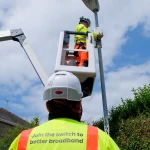NIC Calls for More Action on 5G and Criticises UK 4G Mobile Coverage
The Government’s National Infrastructure Commission (NIC) has today warned that Mobile Broadband and Mobile Voice connectivity in the United Kingdom is “languishing in the digital slow lane” and that there are still “too many digital deserts and partial not spots” with 4G coverage.
In fairness most of the major mobile network operators (EE / BT, Three UK, Vodafone and O2) have either already achieved 98% population coverage of the United Kingdom or they’re only a few percentage points off achieving that goal by the end of 2017 as planned, although the situation for geographic coverage (landmass) is much more challenging.
For example, EE benefited from a head-start on their 4G deployment and as a result their population coverage has already hit 98%, but this drops to just 70% for “geographic coverage“. On the upside the operator aims to improve geographic coverage to 92% by September 2017, followed by 95% by the end of December 2020 and that’s better than most, but even then some gaps will remain.
Advertisement
Despite this on-going work the NIC warns that availability of 4G networks in the UK is “worse than many countries including Albania, Panama and Peru” and they want the Government and Ofcom to “ensure that essential outdoor mobile services – such as basic talk, text and data – are available wherever we live, work and travel.”
Coverage is the main issue here, but network speed and performance is also described by the new report as “languishing in the digital slow lane.” On the other hand Akamai’s State of the Internet report for Q2 2016 (here) claimed that we actually had the fastest Mobile Broadband speeds in Europe and a recent study from Ookla also returned some good scores (here).
At this point it’s all too easy to forget that today’s report was actually setup to examine the future of “ultra-fast” (20Gbps capable) 5G Mobile connectivity, which is currently still in the research phase and isn’t expected to be rolled out until around 2020.
Lord Adonis, Chair of the Commission, said:
“5G is the future – ultra-fast, and ultra-reliable it has the potential to change our lives and our economy in ways we cannot even imagine today. But the UK is currently languishing in the digital slow lane.
Britain is 54th in the world for 4G coverage, and the typical user can only access 4G barely half the time. Our 4G network is worse than Romania and Albania, Panama and Peru. Our roads and railways can feel like digital deserts and even our city centres are plagued by not spots where connectivity is impossible. That isn’t just frustrating, it is increasingly holding British business back as more and more of our economy requires a connected workforce.
5G offers us a chance to start again and get ahead. If government acts now we can ensure our major transport networks and urban centres are 5G ready in time to give British industry every chance to lead the world in exploiting its applications.
But none of this will matter unless we bring our mobile network up to speed. The existing system does not provide the level of coverage we will need in our connected future. We need a new universal service obligation which ensures that the mobile essentials – like text, talk and data – are available to us wherever we need them.
From connected vehicles to the internet of things, 5G will support a whole new way of communicating and doing business. The UK must not be left behind.”
As ever there will be many challenges involved in achieving the universal level of coverage (i.e. Universal Service Obligation for mobile) that today’s report appears to be seeking, not least of which will be the issue of actually being able to build the necessary infrastructure in the first place.
Advertisement
Getting planning permission to build new masts and accessing the necessary data capacity or power supply is rarely an easy or cheap task and often meets local opposition, as well as unenthusiastic land owners who demand high rental prices or restrict access. Not to mention the challenge of getting mobile operators to agree on the distribution of radio spectrum and related matters.
The Digital Economy Bill 2016-17 hopes to produce some solutions for this and today’s report includes a variety of additional proposals, but it’s debatable whether all of this can be delivered by the NIC’s proposed deadline of 2025; particularly as we don’t yet have the full and final picture for what 5G will actually look like.
Meanwhile Conservative MP Grant Shapps, who recently published a scathing report into UK mobile coverage that attracted the support of 90 cross-part MPs (here), has criticised the Government for believing too much of what telecoms operators tell them. “Over the years, ministers have been far too easy on the glib promises given by the telecoms providers and I think that has been combined with ineffective and weak regulation from Ofcom,” said Shapps.
The FULL Recommendations
Recommendation 1:
Digital infrastructure lies at the heart of the UK’s industrial strategy and affects every sector of the economy. To reflect its importance, ultimate government responsibility for digital infrastructure should reside in one place under a single cabinet minister with the authority to shape policy and delivery across government ensuring that it delivers the government’s overarching digital strategy. This work should report to the Economy and Industrial Strategy Cabinet Committee. It should:
* Identify the public projects that contain a significant element of digital infrastructure and establish and maintain a plan which sets out how they can help deliver the government’s overarching digital strategy and maximise the benefit of better mobile telecommunications for UK citizens and businesses.
* Hold the various parts of government that are delivering digital infrastructure to account, in order to ensure adequate telecoms network provision in the delivery of its infrastructure programmes.
* Ensure that when upgrading existing or delivering new infrastructure, such as that alongside our roads and railways, the long term capacity needs of telecoms networks are considered and met. This could include installing more fibre and additional infrastructure to make sure that networks are future-proof. It will also mean ensuring that the networks are readily accessible to communications providers.
* Be a centre of telecoms expertise within government that supports departments in determining their needs and procuring telecoms infrastructure, and support departments in demonstrating and testing of new, digitally-enabled ways of delivering public services such as education and healthcare.
* Support and challenge local government in their plans to enable the delivery of digital infrastructure; both in terms of ensuring that these plans help the UK to meet its national objectives, and that local authorities develop consistent approaches to support the deployment of mobile infrastructure across the country.
Recommendation 2:
Our motorways must have mobile telecommunication networks fit for the future. It is vital that our motorways are able to meet both the long term operational needs of connected vehicles and the connectivity needs of the passengers. This will necessitate the timely installation of an open and accessible mobile telecommunication and backhaul network that is fit for the future.
The government should set out its plans for how to deliver this by the end of 2017. As part of this work consideration should be given to who is best placed to install, manage, fund and own the network, noting the potential for private sector funding. Ensuring that best use is made of the existing infrastructure, such as masts, poles, ducts power supplies and the fibre network alongside our motorways, so that it can be used to support the backhaul of mobile data will be essential.
Ultimately, the government should ensure that the necessary infrastructure is in place on motorways by 2025 at the latest if it wants to offer a reasonable level of connectivity on a timescale consistent with the deployment of 5G networks. Ofcom should set out how a regulatory regime would support these different operating models.
Recommendation 3:
Rail passengers should have high capacity wireless connectivity. This should be achieved through a delivery model that utilises trackside infrastructure to provide an open and accessible mobile telecommunication and backhaul network that is fit for the future.
The government should set out its plans for how to deliver this by the end of 2017. As part of this work consideration should be given to who is best placed to install, manage, fund and own the network, noting the potential for private sector funding. Ensuring that best use is made of the existing infrastructure, such as masts, poles, ducts power supplies and the fibre network alongside our railways so that it can be used to support the backhaul of mobile data will be essential.
Ultimately, the government should ensure that the necessary infrastructure is in place on the main rail and key commuter routes by 2025 at the latest if it wants to offer a reasonable level of connectivity on a timescale consistent with the deployment of 5G networks. Ofcom should set out how a regulatory regime would support these different operating models.
Recommendation 4:
Local government should actively facilitate the deployment of mobile telecoms infrastructure:
a) Local authorities should work together and with Local Enterprise Partnerships (LEPs) to develop coordinated local mobile connectivity delivery plans. These plans should:
* set out how local authorities and LEPs will enable the deployment of mobile networks and maximise the opportunities and benefits to residents and businesses;
* be developed in discussion with mobile network operators and infrastructure owners;
* identify a designated individual with lead responsibility for engaging with mobile telecoms infrastructure providers;
* consider the role of local government assets and infrastructure, (e.g. land, buildings, roads, street furniture) and help coordinate the role that other public buildings in an area (e.g. hospitals and universities) can play to facilitate the deployment of mobile telecoms infrastructure; and
* consider how the deployment of digital infrastructure can be established as a priority in local planning policy.
Local authorities and LEPs should report annually to the government department with responsibility for digital infrastructure on their progress delivering against these plans.
b) Local models for facilitating the deployment of these networks should be piloted and evaluated to inform national roll-out. Any pilot programme should allow for the evaluation of deployment models in different types of area (e.g. urban, rural, coastal) and in both single-tier and two-tier local government areas. It should also seek to establish how high quality design can minimise the impact of hosted infrastructure on the built environment. Such pilots would be a good use of a proportion of the funding recently announced in the Autumn Statement to support mobile telecoms infrastructure.
Recommendation 5:
Government and Ofcom should develop a meaningful set of metrics that represent the coverage people actually receive and use these to determine a mobile universal service obligation setting out the minimum service level people should expect to receive.
a) Ofcom, government and mobile operators should report their coverage so that they are genuine and meaningful reflections of the services enjoyed by customers. Metrics should be measurable and based on the reality of service and coverage provided to customers, not based on simulated or predicted performance. Ofcom should set out how this is best achieved by the end of 2017. Ofcom and government should use these metrics as the basis of future interventions such as spectrum licence obligations or voluntary agreements with operators. Government, Ofcom or the Advertising Standards Authority should take action if operators advertise or report coverage in a way that does not reflect services being delivered to consumers on an everyday basis.
b) Mobile services are increasingly viewed as essential, underpinning our daily lives and the digital economy. Government must deliver a view by the end of 2017 on what aspects of mobile services are considered “essential”. It should then establish how this “essential” level of service provision can be made available through a mobile universal service obligation regardless of the network to which a customer is subscribed. Government should engage with Ofcom and industry to establish the best delivery mechanism, whether through spectrum licence obligations, enabling roaming, enabling cross operator Mobile Virtual Network Operators (MVNOs), through government procurement or a mix thereof. Government with the assistance of Ofcom should deliver this as soon as is practical but no later than 2025.
Recommendation 6:
By the end of 2017 Ofcom and government must review the existing regulatory regime to ensure that it supports the sharing of telecoms infrastructure. This will be particularly important for areas of the country where competition driven markets have struggled to provide the necessary mobile infrastructure.
Recommendation 7:
Ofcom and government must ensure they keep pace with the rapid evolution of the mobile communications market, and that the regulatory regime is fit for purpose. By the end of 2017 Ofcom and government must review the regulatory regime to ensure that spectrum allocation and regulatory decisions support a growth model in a world where technology developments enable greater shared access and interoperability. Government and Ofcom should review how unlicensed, lightly licensed spectrum, spectrum sharing and similar approaches can be utilised for higher frequencies to maximise access to the radio spectrum. Spectrum decisions should where possible enable:
* Community or small provider solutions to meet the needs of local areas if they remain unserved or poorly served.
* Niche entrants or sub-national players to access the higher frequency spectrum anticipated for 5G. Allocation of nationwide spectrum licenses to a small number of operators could leave large areas of the UK fallow.
* Businesses, universities and others to access spectrum where they need to within their factories or buildings, including already licensed spectrum if there are no interference risks. This will unlock multiple wireless service provider options, including self-provision, spurring the innovation in industrial internet of things, wireless automation and robotics.
Mark is a professional technology writer, IT consultant and computer engineer from Dorset (England), he also founded ISPreview in 1999 and enjoys analysing the latest telecoms and broadband developments. Find me on X (Twitter), Mastodon, Facebook, BlueSky, Threads.net and Linkedin.
« DEBill – Land Owners Demand More Details on 10Mbps Broadband USO
















































Comments are closed